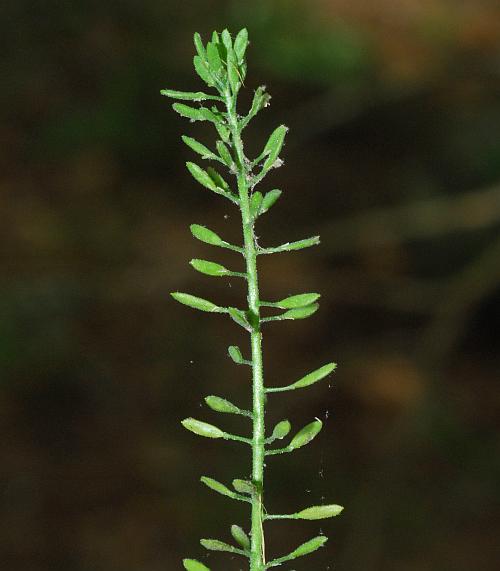Draba aprica Beadle
Open-Ground Whitlow Grass

Native
CC = 10
CW = 5
MOC = 9
© SRTurner
Draba aprica BeadleOpen-Ground Whitlow Grass | |
 |
Native CC = 10 CW = 5 MOC = 9 |
© SRTurner |
|
Family - Brassicaceae Habit - Annual forb. Stem - Ascending to erect, usually single and unbranched, to 40 cm, hairy.
Leaves - Basal and alternate, more or less evenly distributed along the stems, 0.4-2.0 cm long, sessile or the basal leaves often short-petiolate, linear to obovate or broadly elliptic, the margins entire or less commonly few-toothed, hairy on both surfaces.
Inflorescences - Axillary and terminal panicles, the branches often short and densely flowered. Flowers dense, those of the lateral branches often appearing fascicled.
Flowers - Sepals 0.8-1.5 mm long. Petals 2-3 mm long (sometimes absent), white, rounded or very slightly indented at the tip. Styles absent or to 0.2 mm long. Fruits - Fruits 3-6 mm long, linear to narrowly elliptic in outline, hairy. Seeds 4-8 per fruit.
Flowering - April - May. Habitat - Streambanks, forest openings, rock outcrops and ledges of shut-ins, glades, roadsides. On both calcareous and acidic substrates. Origin - Native to the U.S. Lookalikes - Other species of Draba, particularly D. brachycarpa. Other info. - This small and inconspicuous species is found in Missouri in only a few counties in the St. Francois Mountains region. Its larger distribution is limited to only 6 states within the southeastern quadrant of the continental U.S., and it considered rare everywhere outside of Missouri. Clues to its identity as a Draba include its small stature, branched hairs on the herbage, white flowers, and football-like fruit shape which falls between silique (very long and slender) and silicle (nearly round in profile). D. aprica is distinguished from other species of Draba by its leafy stems and hairy fruits. Photographs taken at Silver Mines Recreation Area, Madison County, MO, 5-12-2015, and at Millstream Gardens Conservation Area, Madison County, MO, 4-28-2020 (SRTurner). |